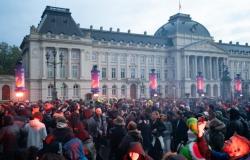The aging is mainly due to the female candidates, according to the analysis, which covers the last ten consecutive parliamentary elections and therefore covers a period of 37 years. More than 10,000 candidate profiles were analyzed based on age, gender and place of residence. Flemish parties that participated in all elections since 1987 and obtained seats were included: CVP/CD&V, PVV/VLD/Open VLD, SP/sp.a/Vooruit, Agalev/Groen, Vlaams Blok/Belang and VU/VU-ID/ N-VA. For PVDA, the data is limited to the lists of 2014, 2019 and the current lists.
For the first time, female candidates have a higher average age than men. A woman on a list is on average 47.8 years old, a man is on average 46.4 years old. The age of women has increased sharply since the previous elections from 43.2 years in 2019 to 47.8 in 2024. For men it went from 45.8 to 46.4 years.
Moreover, for the first time since 1987, there are more older (15.8 percent) than younger (13.2 percent) candidates. By ‘older candidates’ the researchers mean people over 61 years old, ‘younger candidates’ fall into the category of 18 to 30 year olds.
“Never before has the average candidate been so old. This is surprising and difficult to reconcile with the strong focus on first-time voters in the campaign so far,” researchers Bart Maddens and Toine Paulissen write. “Apparently it has become more difficult for Flemish parties to recruit younger candidates for their lists?”
Oldest candidates at Vlaams Belang
Open VLD currently has the youngest candidates (average 44 years), followed by CD&V (45.2 years) and PVDA (45.6 years). This is followed by Vooruit (46 years), Groen (46.6 years) and N-VA (47.3 years). Vlaams Belang stands out in terms of aging with an average of 52.5 years, while in the late 1980s that party often had young candidates in its ranks. Groen has gone through a similar evolution: Groen had the youngest candidates in 1987, and is now in the middle bracket.
When looking at the ‘electable candidates’, the candidates who have a good chance of being elected, a trend break is visible. There has been a rejuvenation in this group since the 1990s, but the current candidates are again older on average than those in 2019 (46.5 years compared to approximately 43.8 years).
The average age among eligible candidates does give a somewhat distorted picture, the researchers warn. “Some parties appear to have made an effort to put more young people in eligible positions,” say Maddens and Paulissen. “The share of young people among eligible candidates is now 5.6 percent. That may not seem like much, but it is significantly more than in 2019, when 2.2 percent of young people were in eligible positions, and the highest share since 1987.”
Vlaams Belang, Open VLD and Vooruit in particular are driving forces in this respect: in these parties, 16.6 percent, 11.1 percent and again 11.1 percent of the eligible places are reserved for young people, respectively. The other parties, on the other hand, have not made any eligible places for young people.
Another striking conclusion is that the percentage of women among eligible candidates will decrease in 2024. It is the first time that this has happened: the share of women rose steadily from 12.6 percent in 1987 to 47.6 percent in the previous elections, but now drops again to 45.2 percent. Groen, Vlaams Belang and Open Vld in particular have fewer women in eligible positions, while CD&V has seen a significant increase in the share of women in eligible positions.
Tags: Candidates Flemish parliamentary lists oldest forty years
-





